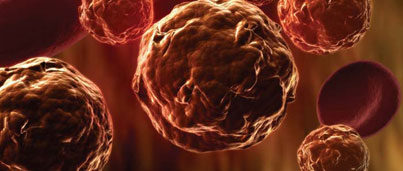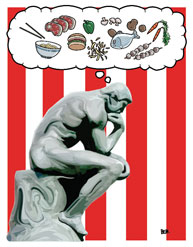Insights
Beating Back Viruses

Viruses on the attack
ISTOCKPHOTO.COM
McGill researchers have discovered a way to boost a mouse's natural anti-virus defences, effectively making its cells immune to influenza and other viruses.
The work was conducted by postdoctoral fellows Rodney Colina and Mauro Costa-Mattioli, in collaboration with biochemistry professor Nahum Sonenberg and researchers from the Institut de Recherches Cliniques de Montréal and the Ottawa Health Research Institute. The study was recently published in Nature.
The scientists' strategy — which could lead to the development of new anti-viral therapies in humans — involved knocking out two genes in mice that repress the production of interferon, a protein that represents the cell's first line of defence against viruses.
Without these repressor genes, the mouse cells produced much higher levels of interferon, which effectively blocked viruses from reproducing. The researchers tested the process on four different types of viruses, including influenza.
Viruses are sub-microscopic infectious agents which can reproduce only by hijacking a cell's reproductive machinery, a process that usually leads to disease. Interferon, particularly the type 1 interferons (IFN-α and IFN-β), suppresses virus propagation.
Production of type 1 interferon is controlled by the interferon regulatory protein 7 (Irf7), which researchers believe is the "master-regulator" of interferon production in the body. The McGill-led team found that protein synthesis of Irf7 is controlled by the repressor genes called 4E-BP1 and 4E-BP2.
"In a sense, it's quite a simple story," Costa-Mattioli explains. "When you get rid of the repressors, you have more of the key protein Irf7 present, which induces an anti-viral state in the cell. You're basically removing the brakes."
Costa-Mattioli says his team detected no negative side-effects resulting from enhanced interferon production in the mice. While the process of knocking out genes is not possible in humans, the researchers are optimistic that new pharmaceutical therapies will evolve from their research.
"If we are able to target 4E-BP1 and 4E-BP2 with drugs, we will have a molecule that can protect you from viral infection," Costa-Mattioli says. "That's a very exciting idea."

Bernie Mireault
Food for Thought
There is a growing appetite among Canadian academics for information on food — and not just about the best restaurants located near campus.
Anthropologists, sociologists, historians and others all have a keen interest in the things we've eaten over the years and what these meals — and how they've been prepared and consumed — have to say about us.
Associate professor of English Natalie Cooke, who examines how Canadian cookbooks reflect the culture of their times, is part of this scholarly movement.
She is also the executive editor of Cuizine: The Journal of Canadian Food Cultures, a digital-only publication launching this spring. The new publication's managing editor is Lara Rabinovitch, BA'02, a doctoral candidate at New York University and an expert on how Jewish immigrants from East Central Europe affected food trends in North America— Montreal smoked meat is one tasty example.
"I think we're just at the moment where the floodgates will open," says Cooke of the burgeoning academic field of food culture. While scholarly publications like Gastronomica exist south of the border, there hasn't been a comparable forum for Canadians. "We're hopeful that this will be a hub for bringing together people from across the country and from a variety of backgrounds," says Cooke. The first issue includes an essay by celebrated Vancouver chef Vikram Vij on "What it Means to Cook in Canada," an article exploring the links between gastronomy and architecture, and cartoons from John Dolgin, BA'00 (a.k.a. cross-cultural hip-hop performer Socalled).
For more information, visit cuizine.mcgill.ca.


